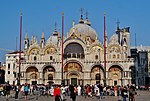St Mark's Clock

St Mark's Clock is housed in the Clock Tower on the Piazza San Marco (Saint Mark's Square) in Venice, Italy, adjoining the Procuratie Vecchie. The first clock housed in the tower was built and installed by Gian Paolo and Gian Carlo Rainieri, father and son, between 1496 and 1499, and was one of a number of large public astronomical clocks erected throughout Europe during the 14th and 15th centuries. The clock has had an eventful horological history, and been the subject of many restorations, some controversial. After restorations in 1551 by Giuseppe Mazzoleni, and in 1615, by Giovanni Battista Santi, the clock mechanism was almost completely replaced in the 1750s, by Bartolomeo Ferracina. In 1858 the clock was restored by Luigi De Lucia. In 1996, a major restoration, undertaken by Giuseppe Brusa and Alberto Gorla, was the subject of controversy, amid claims of unsympathetic restoration and poor workmanship.
Excerpt from the Wikipedia article St Mark's Clock (License: CC BY-SA 3.0, Authors, Images).St Mark's Clock
St. Mark's Square, Venice Venezia-Murano-Burano
Geographical coordinates (GPS) Address Nearby Places Show on map
Geographical coordinates (GPS)
| Latitude | Longitude |
|---|---|
| N 45.434599 ° | E 12.338923 ° |
Address
Bandiera Europa
St. Mark's Square
30170 Venice, Venezia-Murano-Burano
Veneto, Italy
Open on Google Maps









